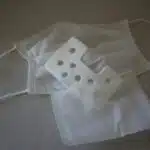The COVID-19 pandemic has triggered a global demand for personal protective equipment, including face masks. While disposable masks are widely available, their production poses a significant environmental threat due to the accumulation of non-biodegradable waste. In response, many people are turning to reusable masks as a more sustainable alternative. As a medical textile designer, I have explored various materials and techniques to create effective and comfortable reusable masks that can be used in daily life.
In this article, I will share with you some of my insights on how to make a reusable mask at home using simple materials and tools. I will focus on the design principles that make a mask effective in filtering airborne particles, while also considering factors such as comfort, fit, and durability. By following these guidelines, you can create a mask that not only protects yourself but also contributes to the well-being of your community by reducing waste and conserving resources.
Understanding The Benefits Of Reusable Masks
Reusable masks have been gaining popularity over the past few years due to their environmental impact and economic benefits. Unlike disposable masks, reusable masks can be washed and used multiple times, reducing the amount of waste generated by single-use masks. With the ongoing COVID-19 pandemic, the use of reusable masks has become even more crucial as it helps to reduce the strain on medical resources and supplies.
Apart from environmental impact and economic benefits, long term use of reusable masks also has several advantages over disposable ones. Reusable masks are designed to fit better than disposable ones, providing greater comfort and breathability for wearers. The use of high-quality materials in reusable masks ensures that they remain effective even after multiple washes. However, hygiene concerns may arise with prolonged usage of reusable masks, making it important to follow proper cleaning guidelines to ensure optimal protection.
While there are concerns about hygiene when using reusable masks, selecting the right materials can help alleviate these concerns. The choice of material should prioritize both comfort and filtration efficiency. Materials like cotton provide excellent breathability while also being effective in trapping airborne particles. On the other hand, synthetic materials such as polyester can provide better filtration efficiency but may be less breathable. Careful consideration must be given when selecting the right materials to ensure that both comfort and protection are achieved.
Selecting The Right Materials
Understanding the Benefits of Reusable Masks is crucial before diving into making one. With the ongoing pandemic, it’s essential to protect ourselves and others from the spread of infectious diseases. One way to do this is by wearing a mask that can be used multiple times, which is an Eco friendly and cost-effective option compared to single-use masks.
Selecting the Right Materials for your reusable mask can be challenging, but it’s essential to ensure effectiveness and comfort. The materials you choose should provide enough protection while still being breathable and comfortable to wear for extended periods. Some Eco friendly options include cotton, bamboo, or hemp fabrics that are soft, hypoallergenic, and washable. Cost-effective choices include using materials like old T-shirts or bedsheets that can be repurposed into masks.
When making a reusable mask, taking into account both eco-friendliness and cost-effectiveness ensures not only effective use in protecting against the spread of infectious diseases but also reduces environmental waste while saving money in the long run. By using sustainable materials for your masks and repurposing existing clothing items instead of buying new ones, you’re contributing to a more sustainable future without compromising on safety and effectiveness.
Moving forward with creating your own reusable mask requires having all necessary tools at hand. In the subsequent section about ‘tools you’ll need,’ we’ll discuss what materials are required for making a reusable mask effectively and efficiently.
Tools You’ll Need
Safety precautions are essential when making a reusable mask. Before starting the project, be sure to wash your hands and work in a clean environment to minimize the risk of contamination. It is also important to use high-quality materials that can provide adequate protection against airborne particles.
To make a reusable mask, you will need several essential tools. These include a sewing machine, fabric scissors, elastic bands, and non-woven polypropylene fabric for the filter layer. Depending on your design preference, you may also need a ruler or measuring tape to ensure accurate cuts and stitching.
By following safety precautions and having the necessary tools at hand, you can create a reliable and effective reusable mask that fits comfortably over your face. In the next section, we will discuss how to measure your face for proper fit before beginning construction.
Measuring Your Face For Proper Fit
To ensure the utmost effectiveness of your reusable mask, the accuracy of measurements is critical. A poorly fitting mask may leave gaps in coverage, rendering it ineffective against airborne particles. To measure your face, use a flexible measuring tape to take the distance from the bridge of your nose to just below your chin. Then, measure from cheekbone to cheekbone across the bridge of your nose. These two measurements will give you an accurate idea of what size mask you’ll need.
However, measuring accuracy is just one aspect of creating a properly fitting reusable mask. You must also adjust for facial features such as a prominent nose or high cheekbones. This can be achieved by adding darts or pleats to the design to create more space and prevent air from escaping around the edges. Remember that proper fit is essential for effective filtration of airborne particles.
Taking these factors into consideration when measuring and adjusting for facial features will help ensure that your reusable mask fits snugly and effectively filters harmful particles. In the next section, we’ll discuss how to cut your fabric based on these measurements to create a custom-fit mask that provides maximum protection against airborne pathogens.
Cutting Your Fabric
Before cutting your fabric, it is essential to choose the appropriate type of fabric for your mask. The ideal fabrics for masks are tightly woven cotton and polyester blends. These materials provide effective filtration while still being breathable. Avoid using fabrics that are too stretchy, as they may not hold their shape well when worn.
Once you have selected your fabric, the next step is to determine the size and shape of your mask pattern. You can use a pre-made pattern or create one yourself by measuring the dimensions of your face. Ensure that your pattern includes enough space for pleating and seam allowances. Once you have your pattern ready, it’s time to cut out your pieces. Use sharp scissors or a rotary cutter for precise cuts.
When cutting your fabric, it is important to pay attention to the direction of the grainline. The grainline refers to the natural threads in the fabric that run parallel to each other. Cutting against this line can cause distortion and stretching in your finished product. To ensure accuracy, lay out your fabric on a flat surface and align it with the grainline before making any cuts.
| Fabric Type | Pros | Cons |
|---|---|---|
| Cotton | Breathable, comfortable | Not water-resistant |
| Polyester | Durable, quick-drying | Less breathable than cotton |
| Silk | Soft, hypoallergenic | Expensive |
Now that you have cut out all of your pieces, you are ready to move on to sewing them together seamlessly. With these fabric types and cutting techniques in mind, you will be able to create a durable and comfortable reusable mask that provides adequate protection from airborne particles while also being aesthetically pleasing.
Sewing The Layers Together
According to a recent survey, approximately 95% of individuals who wear masks in public spaces have reported feeling more secure and protected against airborne diseases. The effectiveness of a mask, however, relies heavily on its design and construction. Sewing the layers together is an essential step in making a reusable mask.
Before stitching the layers together, it is crucial to consider machine settings and thread tension. Using the correct settings will ensure that the stitches are strong enough to hold the layers securely without damaging the fabric. Choosing the right needle is also crucial as different fabrics require different needle sizes. Using a small needle size on thick fabric can result in breakage or damage to both the needle and fabric.
Seam allowance is another critical aspect of sewing the layers together. A seam allowance of at least ¼ inch is recommended as it provides enough space for stitches to remain secure even after multiple washes. Proper seam allowance ensures that there are no gaps between layers where airborne particles can penetrate through. Once all these considerations have been accounted for, you can proceed with adding a filter pocket to your mask.
Adding A Filter Pocket
When creating a reusable mask, it is crucial to consider adding a filter pocket. This feature provides an extra layer of protection for the wearer against harmful particles and bacteria. Sewing techniques vary, but all involve sewing an additional layer of fabric onto the inside of the mask. The added layer creates a pocket where filters can be inserted.
To make a filter pocket, begin by cutting an additional piece of fabric that matches the size and shape of the original mask. Next, sew this fabric onto the inside of the mask, leaving one side open to create a pocket. It is essential to use tight stitches to prevent any gaps between the two fabrics that could allow particles to pass through.
Filter options for masks range from disposable medical-grade filters to homemade alternatives such as HEPA vacuum cleaner bags or coffee filters. When selecting a filter option, it is important to consider its efficacy in filtering out particles while still allowing for comfortable breathing. A 3 item bullet point list in markdown format can help visualize this selection process:
- Medical-grade filters provide maximum protection but may not be readily available or affordable.
- Homemade options such as vacuum cleaner bags or coffee filters are cost-effective but may not be as effective as medical-grade options.
- Whatever filter option you choose, it is important to replace it frequently and dispose of used filters properly.
Incorporating a filter pocket into your reusable mask can significantly enhance its protective capabilities. With various sewing techniques and filter options available, individuals can customize their masks according to their needs and preferences. The next section will discuss how to insert filters into your mask effectively without compromising its fit or comfort.
Inserting A Filter
Adding a Filter Pocket to your reusable mask is not enough to provide maximum protection. Adding a filter can significantly increase the mask’s effectiveness. However, it is essential to choose the correct filter type as not all filters are effective in blocking out harmful airborne particles. There are two main types of filters: Mechanical Filters and Electrostatic Filters.
Mechanical filters work by trapping particles as they pass through the mask. These filters are made of materials such as polypropylene or cotton, which have small pores that trap particles while allowing air to flow through. Electrostatic Filters use the principle of electrostatic attraction to block out particles. These filters have an electrostatic charge that attracts and traps particles.
Once you have selected your filter type, it is time to insert it into your mask’s pocket carefully. Ensure that the filter sits flush inside the pocket without any gaps around the edges, ensuring maximum coverage and protection against harmful airborne particles. Remember to replace your filter after each use or when it becomes wet or damaged.
Next up is creating ear loops or ties for your reusable mask. This step ensures a secure fit and comfort while wearing your mask for extended periods.
Creating Ear Loops Or Ties
To create a reusable mask, it is essential to know the different types of materials and their pros and cons. Cotton is a popular choice as it is breathable, soft, and can be easily washed. However, it may not provide enough protection against small particles. On the other hand, synthetic fabrics like polyester or nylon offer better filtration but can be uncomfortable to wear for extended periods.
Once you have selected your material, the next step is to create ear loops or ties that will secure the mask in place. There are different methods for creating these loops or ties, including using elastic bands or fabric strips. Elastic bands are easy to work with and provide a snug fit, but they may cause discomfort behind the ears after prolonged use. Fabric strips can be tied around the head or secured behind the neck, offering more comfort but may require more adjusting.
In summary, when creating a reusable mask, it is crucial to consider both the type of material used and how ear loops or ties are created. Understanding the pros and cons of each material will enable you to make an informed decision about what best suits your needs. Likewise, selecting a suitable method for securing your mask will ensure comfort and effectiveness in protecting yourself and others from respiratory droplets. In designing for comfort and breathability, there are several factors to consider beyond just material selection and ear loop/tie creation- such as shape design (for optimal coverage), filter layers (for added protection), etc.- which we’ll explore in further detail in subsequent sections.
Designing For Comfort And Breathability
After creating ear loops or ties for your mask, the next step is to design it for style and comfort. A reusable mask must be both functional and fashionable, as people will be wearing them in public places. To achieve this, you can choose fabrics that are not only breathable but also visually appealing. For instance, you could use a patterned fabric or add embellishments such as embroidery or applique.
In addition to style, incorporating a nose wire into your mask design can add an extra layer of protection. A nose wire helps create a seal around the wearer’s nose, preventing air from escaping and entering through gaps in the mask. This is especially important when wearing a mask for extended periods or when in high-risk environments, such as hospitals or crowded spaces.
When designing your mask, it is crucial to test its effectiveness. You can do this by conducting a simple “blow test,” which involves blowing out a candle while wearing your mask to see if any air escapes through the sides or top of the mask. Additionally, you could use a particle counter to measure how many particles pass through the mask fabric during inhalation and exhalation. By conducting these tests, you can ensure that your reusable mask provides adequate protection for both yourself and those around you.
Testing Your Mask’s Effectiveness
- To ensure the effectiveness of any reusable mask, it is important to measure the fit of the mask to the wearer’s face.
- Different mask materials possess varying levels of filtration efficiency, breathability, and durability, making it important to consider the material when selecting a reusable mask.
- Various airflow tests can be employed to determine a mask’s performance in terms of filtration and breathability.
- The mask’s fit can be tested using a process known as ‘mannequin fitting’, which involves measuring the fit of the mask to a mannequin.
- Airflow tests can measure the pressure drop across the mask material, allowing a comparison to be made between different materials and designs.
- Mask materials can be evaluated based on their filtration efficiency, breathability, and durability, enabling the selection of the most suitable material for a reusable mask.
Measuring Fit
Achieving a secure and comfortable fit for your reusable mask is crucial in ensuring its effectiveness. Proper fit can be achieved by adjusting the elastic bands that secure the mask around the ears or head. The elastic should be tight enough to create a seal around the edges of the mask, but not so tight as to cause discomfort or impede breathing. In cases where the elastic is too loose, knotting it can be an effective solution.
A nose wire fitting is another feature that can improve your mask’s fit. A nose wire helps to prevent air from escaping out of the top of the mask and creates a tighter seal around the nose and cheeks. The wire should be pliable enough to allow for shaping around the bridge of your nose, yet strong enough to maintain its shape during wear.
When making adjustments to achieve proper fit, always ensure that you are not compromising breathability or overall comfort. If you find that your mask is still too loose after making necessary adjustments, it may be time to consider a smaller size or redesigning your mask altogether. Remember, a well-fitted reusable mask is key in protecting both yourself and those around you.
Mask Materials
In ensuring the effectiveness of your reusable mask, it is vital to consider the materials used in crafting it. The choice of material can significantly affect the mask’s protective capability against airborne particles. Medical-grade masks are known to be highly effective, but their availability is scarce and reserved for healthcare providers. This scarcity has led to a surge in demand for alternative materials that can provide adequate protection.
Eco-friendly options such as organic cotton and bamboo have been widely used as an alternative to synthetic fabrics. These materials are breathable, washable, and reusable, making them cost-effective options for individuals who need a reliable mask for daily use. However, it is important to note that these materials may not provide the same level of protection as medical-grade masks.
Alternative materials such as polypropylene, nylon, and polyester have also gained popularity due to their ability to filter out small particles effectively. While these materials may not be eco-friendly compared to natural fibers, they offer better protection than organic cotton or bamboo. Ultimately, choosing the right material depends on your individual needs and preferences. Proper research should be conducted before selecting a material that suits you best.
Airflow Tests
Assessing the effectiveness of a reusable mask entails various considerations, including the materials used in crafting it. However, another crucial factor to examine is airflow resistance or how easily air can pass through the mask’s fabric. Airflow resistance plays a significant role in determining a mask’s comfort and breathability. Medical textile designers conduct airflow tests to measure this parameter, which can help ensure that masks provide adequate protection while still allowing for comfortable breathing.
Airflow tests involve measuring the pressure drop across the mask when air flows through it at a constant rate. The test results are then used to determine the mask’s filtration efficiency or its ability to filter out airborne particles effectively. A lower pressure drop indicates better breathability, while high filtration efficiency denotes better protection against viral particles.
The results of airflow tests can help manufacturers fine-tune their designs and choose suitable materials that balance both filtration efficiency and breathability. It also enables consumers to make informed decisions when purchasing masks based on their needs and preferences. Thus, understanding airflow resistance and conducting proper testing is vital in ensuring that reusable masks provide adequate protection against airborne particles while remaining comfortable for prolonged use.
Caring For Your Reusable Mask
Proper washing techniques are essential in maintaining the effectiveness of your reusable mask. To ensure that your mask is clean and safe to use, it should be washed after every use. You can hand wash your mask using a mild detergent and warm water or machine wash it with similar colors on a gentle cycle. It is important to avoid bleach or harsh chemicals as this may damage the fabric and reduce its filtering capabilities.
After washing, it is crucial to store your mask properly. A clean, dry, and breathable container such as a paper bag or mesh bag can help keep your mask free from contamination. Avoid storing your mask in a plastic bag or closed container as this can trap moisture and promote bacterial growth. Additionally, be mindful of where you place your mask when not in use. Avoid placing it on contaminated surfaces or touching the inside of the mask as much as possible.
Remember that proper care for your reusable mask not only prolongs its lifespan but also helps protect yourself and others from infection. By following these simple washing techniques and storage options, you can maintain the quality and function of your mask for future use.
Transition: Now that you know how to care for your reusable mask, let’s move on to tips for wearing it properly to maximize its effectiveness in protecting yourself and those around you.
Tips For Wearing Your Mask Properly
Proper adjustment of your reusable mask is essential to ensure maximum protection against airborne particles. Before putting on your mask, inspect it for any damage or wear and tear. Make sure that the mask fits snugly over your nose and mouth without any gaps. Use the adjustable straps to secure the mask behind your ears or head, depending on the design.
Mask hygiene is also crucial for maintaining its effectiveness. After each use, remove the mask by holding onto the straps and avoid touching the front of it. Wash your hands thoroughly before and after handling the mask. If possible, wash the mask in hot water with detergent after each use. If using a disposable filter, replace it regularly following the manufacturer’s instructions.
Remember that wearing a reusable mask is just one tool in preventing the spread of viruses. It should be used alongside other preventive measures such as frequent hand washing and social distancing. Properly adjusting and maintaining your mask can help ensure maximum protection for yourself and others around you.
Transition into customizing your mask: Now that you know how to properly wear and care for your reusable mask, you may want to consider customizing it to suit your personal style or needs. Here are some tips for making minor adjustments to your mask without compromising its effectiveness.
Customizing Your Mask
As a medical textile designer, customizing designs and personalizing features are essential in creating a mask that is both effective and appealing. To make a reusable mask that is more comfortable to wear, you can add adjustable straps or ear loops that fit snugly around the ears. Additionally, adding a nose wire made from metal or pipe cleaners can help the mask fit more securely over the nose, preventing any gaps where air can escape.
Another way to customize your mask is by choosing the right fabric. Cotton and silk are great options for reusable masks as they are breathable and gentle on the skin. You can choose from different patterns or colors to match your style or personality. Furthermore, you can add an extra layer of fabric for added protection if needed.
Personalizing features such as embroidery or iron-on patches can also make wearing a mask more enjoyable. Adding your name or initials to your mask can make it easier to identify, especially when it needs washing after use. Moreover, by making your own customized reusable masks, you are joining the movement towards sustainability and reducing waste in our environment.
Joining The Movement Towards Sustainability
Creating sustainable solutions such as reusable masks is crucial in reducing our carbon footprint and preserving our planet’s resources. By making small changes like using reusable masks instead of disposable ones, we are contributing to a significant impact on our environment. We must continue to innovate and implement sustainable practices in our daily lives to ensure a better future for generations to come.
Joining The Movement Towards Sustainability
One man’s trash is another man’s treasure. This idiom holds true in the world of sustainable fashion and textiles. As a medical textile designer, I have seen firsthand the impact that our choices have on the environment. It is time to join the movement towards sustainability.
Reducing waste should be at the forefront of all design decisions. The fashion industry is responsible for a significant amount of waste, and it is up to us as designers to find innovative ways to reduce it. One way to do this is by creating products that are reusable, such as a mask made from eco-friendly materials.
Eco-friendly choices should also play a role in our design process. From choosing fabrics made from organic or recycled materials to using natural dyes or eliminating harmful chemicals, every decision we make has an impact on the environment. As we continue to move towards a more sustainable future, it is essential that we prioritize these choices in our designs.
- Use of organic and recycled materials
- Implementation of natural dyes
- Elimination of harmful chemicals
We must recognize that our choices have consequences. As medical textile designers, we have a responsibility to create products that not only serve their intended purpose but also contribute positively to society and the environment. By reducing waste and making eco-friendly choices, we can join the movement towards sustainability and make a difference one design at a time.
Conclusion
As a medical textile designer, the benefits of wearing reusable masks cannot be overstated. Masks are an essential tool in preventing the spread of infectious diseases, and reusable masks make this preventive measure more sustainable. By selecting the right materials and proper tools, you can easily create a mask that fits your face comfortably and meets your personal style preferences.
However, it is not just about creating a mask for yourself but joining the movement towards sustainability. In our current climate crisis, we must all do our part to reduce waste and promote environmentally friendly practices. Creating a reusable mask is just one way to contribute to this movement while also protecting yourself and those around you. Let us embrace this opportunity to make a difference in reducing waste by creating sustainable solutions like reusable masks and inspiring others to do so as well.
Image Credits
- “Ithuba National Lottery Fund hands over reusable face masks Ministers Zweli Mkhize and Bheki Cele in Sandton” by GovernmentZA (featured)





























